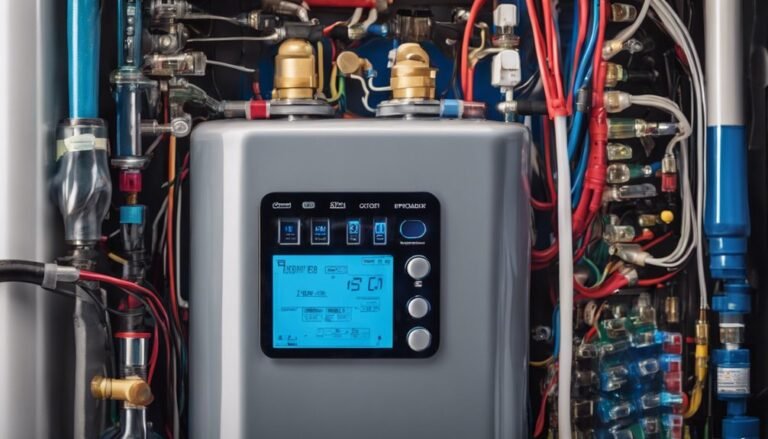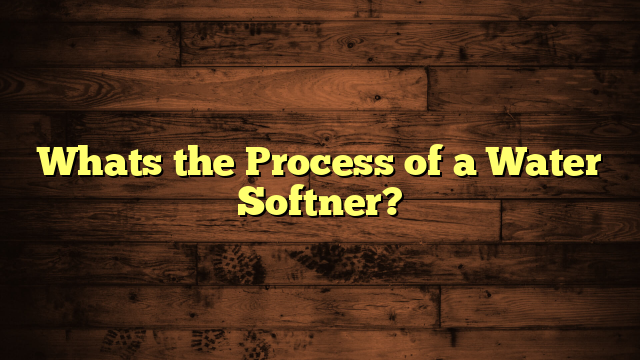What Kind of Waste Comes Out of Water Softner?
When you regenerate your water softener, you might notice a salty discharge that's actually brine solution. This byproduct isn't just a nuisance; it can lead to environmental concerns if not managed properly. Alongside brine, there's also flush water and sediment that accumulate during the process, potentially causing plumbing issues. Understanding the types of waste generated by these systems is essential for responsible maintenance. So, what can you do to minimize these impacts and guarantee your water softener operates efficiently?
Key Takeaways
- Brine Solution: A saltwater byproduct generated during regeneration, which can contaminate water sources if not disposed of properly.
- Flush Water: Excess water used during the regeneration process, contributing to increased water usage and costs.
- Sediment: Particles removed from hard water that can accumulate and cause plumbing blockages over time.
- Backwash: A mixture of softened water and contaminants that is expelled during the cleaning process of the water softener.
- Diluted Sodium: Generated during regeneration, this byproduct can impact the salinity of wastewater if not managed correctly.
Understanding Water Softeners
Water softeners play an essential role in improving water quality by removing minerals like calcium and magnesium that cause hardness. When you install a water softener, you're addressing issues related to water hardness, which can lead to limescale buildup in pipes and appliances, reducing their efficiency and lifespan.
The softener works through a process called ion exchange, where hard minerals are swapped for sodium or potassium ions, effectively softening the water.
To evaluate softener efficiency, you'll want to take into account factors such as the system's capacity and the regeneration frequency. An efficient softener maintains peak performance by minimizing salt usage while effectively removing hardness minerals.
You might also want to monitor the total dissolved solids (TDS) in your softened water, as this can indicate how well your system is working.
Understanding how water softeners function can help you make informed decisions about maintenance and upgrades. Regular checks on the brine tank and resin beads guarantee your system operates efficiently, providing you with high-quality water for daily use.
Types of Waste Generated
When a water softener operates, it generates specific types of waste that can impact both the environment and your plumbing system. Understanding these waste types is essential, as it helps you navigate the associated disposal challenges.
| Waste Type | Description | Impact |
|---|---|---|
| Brine Solution | Saltwater solution from regeneration | Can contaminate freshwater sources if discharged improperly |
| Flush Water | Excess water used during regeneration | May lead to increased water usage and cost, affecting efficiency |
| Sediment | Particles removed from hard water | Can build up in plumbing, causing blockages or damage |
These waste types can complicate disposal efforts. For instance, the brine solution often requires specific treatment before disposal to prevent environmental harm. Similarly, flush water can contribute to higher utility bills if not managed correctly. By being aware of these waste types and their potential disposal challenges, you can make informed decisions about your water softening system and its environmental footprint.
Brine Solutions Explained
Generating a brine solution is a vital process in the operation of water softeners, and understanding its composition and implications is essential. A brine solution typically consists of water mixed with high concentrations of sodium chloride (salt), which is important for the regeneration of the resin beads used in softening hard water.
The brine concentrations can vary based on the softener's settings and local water hardness levels, ultimately impacting the efficiency of the softening process.
During regeneration, the brine solution displaces calcium and magnesium ions from the resin, allowing these hard minerals to be flushed away. However, this process produces wastewater that contains not only excess salts but also the softened water's contaminants.
Effective wastewater treatment is necessary to manage this byproduct, as high brine concentrations can pose environmental challenges if released into local water bodies without proper treatment.
Understanding the role of brine and its implications in wastewater treatment helps you appreciate the importance of managing this waste responsibly. By being informed, you can make decisions about your water softening systems that align with both efficiency and environmental sustainability.
Other Byproducts of Softening
Various byproducts arise from the water softening process beyond just brine solutions. When you soften water, you also generate sediment and small amounts of calcium and magnesium that accumulate in the resin beads of your softener. Over time, this buildup can lead to reduced efficiency in the softening process, necessitating periodic cleaning or replacement of the resin.
Additionally, the regeneration cycle of water softeners can produce diluted sodium, which, while not as harmful as brine, still requires proper waste management to prevent contamination of local water sources. It's crucial to take into account how you'll dispose of these byproducts responsibly, as improper disposal can lead to environmental concerns.
Moreover, some water softening systems generate backwash, a mixture of softened water and residual contaminants, which needs careful handling to guarantee resource conservation. By managing these byproducts effectively, you can minimize negative impacts and make the most of your water softening system.
Understanding these additional waste products can help you devise strategies for better waste management, confirming that your water treatment practices align with sustainable principles.
Environmental Impact of Waste
When considering the environmental impact of waste from water softeners, salt brine disposal becomes a critical issue.
You'll find that this brine can greatly affect local ecosystems, leading to increased salinity in water bodies and harming aquatic life.
Understanding these consequences is essential for evaluating the sustainability of water softening practices.
Salt Brine Disposal
Salt brine disposal poses significant environmental challenges that shouldn't be overlooked. When water softeners regenerate, they release a concentrated solution of salt, known as brine, which can pose risks to local water sources.
Effective brine management is essential to mitigate these risks. If disposed of improperly, the high salinity in brine can contaminate freshwater supplies, harming aquatic life and disrupting ecosystems.
You may want to explore alternative methods for managing this waste. Some municipalities have implemented systems for brine recycling or treatment, which can reduce the environmental footprint of water softening processes.
In addition, investigating salt alternatives can also mitigate the amount of brine produced. Products like potassium chloride or other synthetic options can soften water with less environmental impact compared to traditional salt.
Impact on Ecosystems
The environmental impact of waste generated by water softeners extends far beyond the immediate vicinity of disposal sites. When salt brine is released into waterways, it can greatly disrupt the ecosystem balance. Elevated salinity levels can lead to detrimental effects on aquatic life, particularly species that thrive in freshwater environments.
As you might know, many organisms have a limited tolerance for salt; exposure to higher concentrations can result in stress, reduced reproduction rates, or even mortality.
Moreover, increased salinity can alter the chemical composition of water bodies, affecting not just individual species but entire food webs. This disruption can have cascading effects, leading to declines in fish populations and impacting other wildlife that relies on those fish for sustenance.
In addition, the runoff from salt-laden water can contaminate soil and groundwater, further threatening terrestrial ecosystems.
As you consider the implications of water softener waste, it's essential to acknowledge how these practices can ripple through ecosystems, highlighting the importance of sustainable water treatment options that minimize environmental harm.
Disposal Methods for Waste
When dealing with waste from water softeners, understanding disposal methods is essential for compliance with environmental regulations.
You'll find that options like salt brine disposal and recycling can greatly impact sustainability efforts.
It's important to evaluate each method's effectiveness and environmental implications to make informed choices.
Salt Brine Disposal
How do you handle the disposal of salt brine generated from water softeners? Managing this waste can be tricky, as brine disposal poses significant challenges.
Salt brine, a byproduct of the ion-exchange process, contains high concentrations of sodium and chloride, which can impact local water systems if not disposed of properly.
One common method of brine management involves discharging the waste into sewer systems, where treatment plants can process it. However, not all municipalities accept brine, so it's important to check local regulations.
If sewer disposal isn't an option, you might need to explore alternatives like evaporation ponds or specialized waste disposal facilities designed to handle brine.
Another important factor to take into account is the volume of brine your water softener generates. Larger households may produce more waste, necessitating more frequent disposal or alternative management strategies.
You'll want to evaluate the efficiency of your softener to minimize brine production, as reducing waste can alleviate disposal challenges.
Ultimately, effective brine management is essential for maintaining both compliance and environmental integrity. Understanding your disposal options will help you make informed decisions about managing salt brine from your water softener.
Environmental Regulations Compliance
Steering through environmental regulations is essential when disposing of waste generated by water softeners, particularly salt brine. The disposal of salt brine often poses compliance challenges due to varying regulatory standards across different regions.
You'll need to understand local laws that govern the disposal of high-salinity waste, as improper handling can lead to significant environmental harm and legal repercussions.
In many areas, discharging salt brine directly into storm drains or septic systems is prohibited. Instead, you may need to explore specific disposal methods that meet regulatory requirements, such as utilizing designated waste treatment facilities or engaging in approved land application processes.
These alternatives not only comply with regulations but also help minimize the ecological impact of salt brine.
Moreover, staying informed about updates to regulatory standards is vital, as they can change and influence your disposal practices. Regular consultations with environmental agencies can aid in managing these complexities.
Recycling Options Available
Recycling options for waste generated by water softeners offer viable alternatives to traditional disposal methods, promoting sustainability and reducing environmental impact.
One of the primary waste products of water softeners is brine, which contains high concentrations of sodium and other minerals. Instead of disposing of this brine directly into drainage systems, you can explore recycling brine as a sustainable practice.
Some municipalities have established systems for treating and reusing brine, which can be processed into valuable resources, such as road de-icing agents or agricultural fertilizers.
If your local area lacks these facilities, consider contacting waste management companies that specialize in brine recycling. They can guide you on the best practices for proper disposal and recycling.
Additionally, you might look into installing a water softener that uses less salt or incorporates salt-free technologies.
These options can greatly reduce the volume of brine produced, aligning with sustainable practices while minimizing waste.
Minimizing Waste Production
Minimizing waste production from water softeners is vital for both environmental sustainability and cost-effectiveness. You can implement effective waste reduction strategies to reduce the brine discharge and overall resource consumption associated with water softening systems.
One approach is to choose a high-efficiency water softener that uses less salt and water during the regeneration process. These systems can notably lower the amount of waste generated.
Additionally, consider optimizing your water softener's regeneration frequency. By adjusting the system to regenerate only when necessary, you can greatly reduce salt waste and conserve water.
Regular maintenance of your unit also plays a key role; ensuring that your softener operates efficiently will minimize excess waste.
Incorporating sustainable practices into your water usage habits can further enhance waste reduction. For instance, you might collect and reuse the brine for irrigation purposes where appropriate, or explore options for more eco-friendly salt alternatives.
Ultimately, adopting these strategies not only contributes to a notable decrease in waste production but also supports your commitment to environmental stewardship while saving you money in the long run.
Alternatives to Traditional Softeners
As homeowners seek to reduce their environmental impact and water waste, alternatives to traditional water softeners have gained popularity. One of the most notable eco-friendly alternatives is the salt-free water conditioner. Instead of using sodium ions to soften water, these systems use a process known as template-assisted crystallization, which alters the structure of hard minerals without the need for salt. This method prevents scale buildup while maintaining essential minerals in the water.
Another option is using magnetic or electronic descalers. These devices claim to change the properties of minerals in water, preventing them from adhering to pipes and appliances. While some users report positive results, scientific backing is limited, so it's crucial to evaluate these systems carefully.
Moreover, you might consider using reverse osmosis systems for specific applications, like drinking water. While they can effectively remove impurities, they don't soften water throughout the entire home.
Lastly, rainwater harvesting systems can provide a sustainable source of soft water for outdoor use, reducing reliance on municipal supplies.
Frequently Asked Questions
How Often Should Water Softeners Be Serviced?
You should schedule water softener maintenance at least once a year. However, service frequency may vary based on usage and hardness levels in your water. Regular checks guarantee peak performance and longevity of your system.
Can Waste From Water Softeners Harm Pets?
You might think softener waste is toxic like a supervillain's lair, but it's generally safe for pets. However, always verify proper disposal and keep your pets away from any waste to guarantee their safety.
What Is the Lifespan of a Water Softener?
A water softener lifespan typically ranges from 10 to 15 years. To maximize longevity, follow maintenance tips like regular resin cleaning, salt refills, and checking for leaks. This guarantees efficient performance and reduces replacement costs.
Do Water Softeners Increase Water Bills?
Using a water softener's like adding a new ingredient to your favorite recipe; it can change costs. While they increase water usage slightly, the cost comparison often shows savings in appliance longevity and reduced detergent needs.
Are There Health Risks Associated With Softened Water?
You might wonder about health risks associated with softened water. While some studies suggest minimal risks, softened water offers health benefits, like reduced mineral buildup and improved skin hydration, outweighing potential concerns for most consumers.
Conclusion
In summary, understanding the waste generated by water softeners is essential for both efficient management and environmental responsibility. From brine solutions to sediment, these byproducts can create significant challenges if not handled properly. By implementing effective disposal methods and exploring alternatives, you can minimize waste production and its impact. Ultimately, managing water softener waste is like traversing a maze—one wrong turn can lead to a cascade of issues, but informed choices can keep you on the right path.







